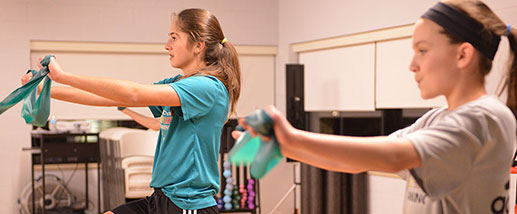Trinity Health Muskegon and Grand Rapids’ World-class Stroke Treatment
May 16, 2023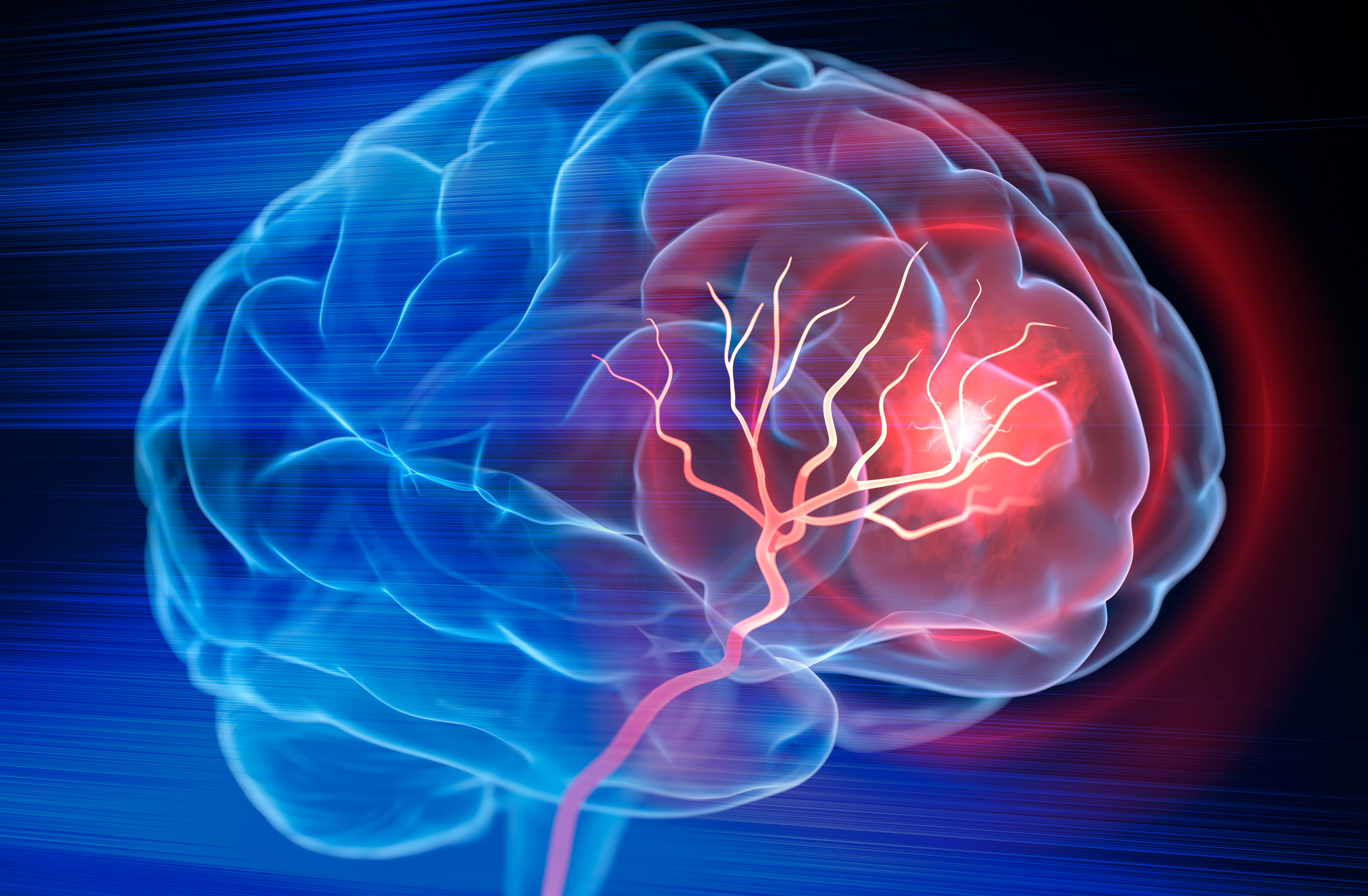
By: Val Enti
Categories: Men's Health, Neurosciences (Brain Spine, Nerves), Women's Health
Tags: Stroke, Stroke care
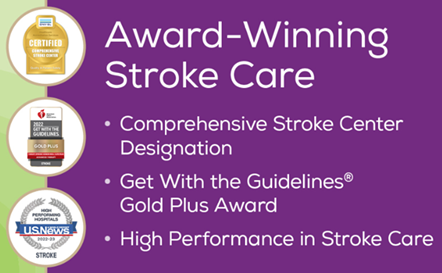 Trinity Health Neurology teams in Muskegon and Grand Rapids deliver extraordinary care to patients experiencing a stroke. Years of experience combined with outstanding expertise have led Trinity Health to receive stroke care certifications that reflect high quality care.
Trinity Health Neurology teams in Muskegon and Grand Rapids deliver extraordinary care to patients experiencing a stroke. Years of experience combined with outstanding expertise have led Trinity Health to receive stroke care certifications that reflect high quality care.
Trinity Health Muskegon is certified as a Primary Stroke Center, which recognizes hospitals that meet standards to support better outcomes for stroke patients. Trinity Health Grand Rapids is certified as a Comprehensive Stroke Center, recognizing that the hospital meets the standards to treat the most complex stroke cases.
In addition, the Grand Rapids Stroke Team recently celebrated their 10th consecutive year of receiving the “Elite Plus Get with the Guidelines” award — the highest award from the American Heart Association for hospitals that demonstrate at least 85 percent compliance in each of the seven Get With The Guidelines®- Stroke Achievement Measures. Trinity Health Grand Rapids is the only hospital in Michigan to have achieved this honor, which reflects the high quality of acute stroke care, rehabilitation, long-term education, and follow-up care by its vascular neurology clinic.
Don’t Hesitate
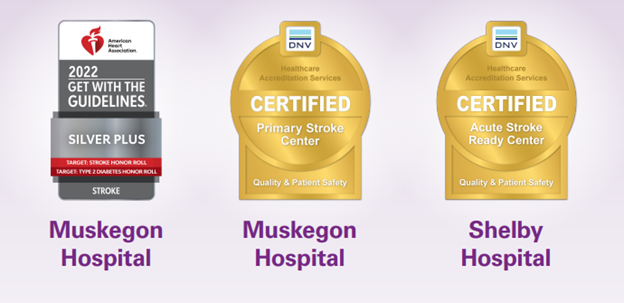 “If you are experiencing stroke-like symptoms, call 911 and go to the Emergency Department in an ambulance,” said the Director of Neurointerventional Services at Trinity Health Grand Rapids and Neurointerventional Radiologist Baljit Deol, MD. “That way, it ensures treatment is received immediately."
“If you are experiencing stroke-like symptoms, call 911 and go to the Emergency Department in an ambulance,” said the Director of Neurointerventional Services at Trinity Health Grand Rapids and Neurointerventional Radiologist Baljit Deol, MD. “That way, it ensures treatment is received immediately."
Driving yourself will necessitate that you go through triage. Arriving by ambulance eliminates that delay and alerts the stroke team to receive you.
“Sometimes when people have symptoms of stroke, they think to themselves, I’ll wait until tomorrow. The delay in seeking care with stroke patients is our greatest challenge. Never hesitate to call 911,” said Dr. Deol (shown at bottom).
Acute Treatment in the Emergency Department
“When a person comes to us in the Emergency Department (ED) with a stroke or stroke-like symptoms, the first thing we assess is whether the patient is a candidate for clot-busting medication,” said Muhammad Farooq, medical director of Vascular Neurology and Neurohospitalist Section at Trinity Health Grand Rapids.
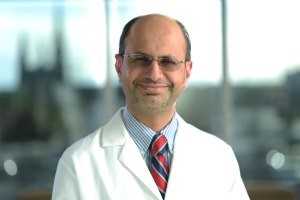 “Patients are eligible for this medication if they arrive at the ED no more than four and a half hours since last known well time — the last time the patient was known to be without the signs and symptoms of a stroke. The medication we use is called TNK (Tenecteplase),” said Dr. Farooq (shown at right).
“Patients are eligible for this medication if they arrive at the ED no more than four and a half hours since last known well time — the last time the patient was known to be without the signs and symptoms of a stroke. The medication we use is called TNK (Tenecteplase),” said Dr. Farooq (shown at right).
An important, little-known fact is that roughly 14-25% of people who have a stroke wake up with symptoms after sleeping — called a wake-up stroke.
“With a wake-up stroke, we don’t know when the stroke occurred or when the patient was ‘last well.’ In that case, we implement a wake-up stroke protocol to determine if the stroke occurred within the acceptable window of time to administer TNK,” Dr. Farooq added.
“Using state-of-the-art equipment, we will complete a computerized tomography (CT) cerebral angiography, which allows us to see the blood vessels in the brain. Another test, called CT profusion, helps us to determine if we can help these patients with neuro intervention. If so, that’s when we call Dr. Deol,” said Dr. Farooq.
Dr. Deol and his intervention team are experts at mechanically removing the clot using a minimally invasive procedure that enters the vascular system through the groin or wrist. When indicated, he may also infiltrate the clot with tPA (tissue plasminogen activator) or another clot-busting medication to soften it for removal.
In rare circumstances, vascular neurosurgery may occur as a life-saving procedure, where a surgical team may remove a part of the skull to relieve pressure inside the brain.
Once the interventional procedure has been completed by Dr. Deol, the patient is transferred from the interventional radiology suite to the Intensive Care Unit (ICU) for careful observation. The length of time in the ICU is based on individual circumstances.
Within two to four weeks following discharge, the patient should return to the Stroke Clinic at the hospital for continued follow-up care. At that time, additional testing may be performed, and speech, occupational, or physical therapy may be ordered.
If a patient comes to the ED with stroke-like symptoms long after the ‘last known well time,’ then the team will complete a series of tests to determine the type and mechanism of stroke and how to proceed with treatment.
Mechanism of Stroke
All of the specialized testing is performed to discover the mechanism of stroke — what caused the stroke.
A patient’s age may help to determine which tests to perform. A person below age 55 is considered young to be having a stroke. “Recently we had 43-year-old stroke patient, and through testing we discovered the mechanism of stroke turned out to be partially genetic,” said Dr. Farooq.
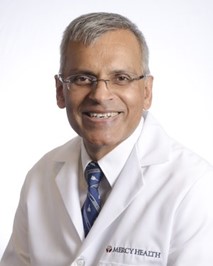 Medications, Healthy Lifestyle, Support Groups, and Specialized Therapies
Medications, Healthy Lifestyle, Support Groups, and Specialized Therapies
Identifying the mechanism of stroke is vital in order to help determine the correct medication for the patient. Individual circumstances determine which medications are prescribed and for how long.
At the follow-up Stroke Clinic appointments, patients are encouraged to live a healthy lifestyle that includes exercise and a healthy diet.
Stroke support groups can also be helpful for patients and caregivers. Some hospitals sponsor their own groups, but larger communities usually have support groups sponsored by other local organizations.
To help with the ongoing healing process, patients may be referred for physical therapy, occupational therapy, or speech therapy — or any combination of these therapies.
Sobering Statistics
Statistics concerning strokes in the United States are worth noting:
- Strokes are the fifth leading cause of death.
- Every three and a half minutes, someone dies of stroke.
- The number one risk for stroke is high blood pressure, often resulting from diabetes, atrial fibrillation, or high cholesterol.
- Nearly 25% of people who are treated for stroke have had a previous stroke.
- 85% of strokes are ischemic, when there is a blockage — lack of blood flow — in the blood vessels to the brain.
- Stroke reduces mobility in more than half of stroke survivors aged 65 and older.
“Nationwide, we need to focus on primary prevention. People need to be aware of risk factors, such as high blood pressure and unhealthy lifestyles.
“As a Catholic organization, we are focused on giving compassionate, expert care and education to everyone, including the underserved. Our corporate culture also encourages collaboration among hospital departments, which leads to outstanding stroke outcomes at Trinity Health,” said Dr. Deol.
Learn more about Trinity Health’s Stroke and Cerebrovascular Disease programs.
Read how Trinity Health’s award-winning stroke care saved a patient who suffered a stroke while driving.
Read about the causes and signs of stroke.
Read how to prevent stroke.
Source of Statistical Facts: Stroke Facts | cdc.gov


